PenInHand - Musings on the Hobby
Lampshades Are More Than Fancy Headgear
by Jim Mamoulides, July 31, 2002
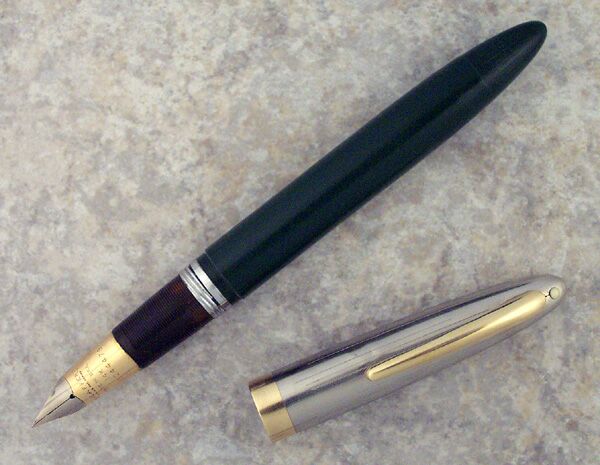
A Typical
"Lampshade" Shot of a Sheaffer TD Sentinel -
You Can Try This At Home
Making good pen photographs is both non-intuitive and simpler than it may seem.
Sleeping Beauties

When Pens Sleep, What Do They Dream Of?
When I first started PenHero.com, I had both a high-resolution scanner and a 3 megapixel digital camera, and like many other people, I found that without any help or grasp of technique, I could make better, sharper and more detailed pen pictures on the scanner than I could using the camera.
The scanner has its good points: anyone can lay pens on the flat clear glass bed of the scanner, cover them with paper or some similar background and scan away. No unusual training, club memberships or secret handshakes are required. The output can be quite sharp, but also has some setbacks. The most annoying problem is flaring. Any really shiny object put on the scanner, things like nibs, chrome or gold plated caps, plated bands, for example, are going to reflect the light from the scanner lamp in a bright line or group of lines that gets picked up in the picture. These are a bear to clean up in a photo editor.

Scanner Flares - They Can Happen To You!
Another problem is color matching. Some scanners have poor color capture and scans can be tinted toward green, for instance. This isn't much of a problem for me, but that's because I'm color-blind. My wife and daughter, who aren't, don't particularly like the green cast some of my early scans had. Why do they do this? Partly because of design - scanners are designed to scan flat objects, like paper. Three dimensional objects reflect light in a way the scanner is not optimized for, and many don't deal with this well, including color capture. Adjustments made in the scanner software may help, but may be different than settings for flat objects, such as pictures.
Last, but not least, is the "sleeping pen" problem. Most of us who have zipped around the internet are probably used to the sleeping pen. The position is a result of gravity. A top down picture showing the clip head on is not physically possible on a flat bed scanner without using some special techniques to hold the pen in place. It's just easier to lay the pen down in the familiar pose.
Lights, Camera, Ack!
So why did I and so many others continue to use scanners when digital cameras offer solutions to all of the problems above? When I first tried my digital camera on a set of pens I had high hopes. I set the pens and background up the way I wanted, put the camera on a tripod, hit the lights and snap. My first pictures were horrible. I discovered through many many snaps that lighting is the key to everything. I could get great color, which was harder to do on the scanner, but less sharpness and detail because the more light washed out the detail, the less light made the pictures too dark. I quickly discovered that lighting is both simple and non-intuitive (I think I started this article here).
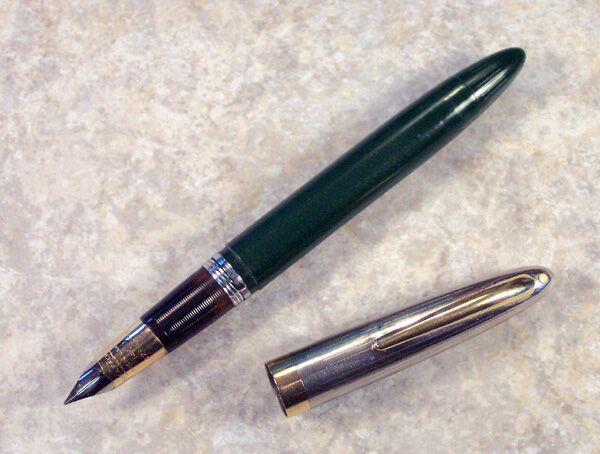
An Example of a Tripod Indirect Light Picture - Ok, But No Cigar
No matter what adjustments I made to direct lighting, I quickly figured out that flaring is not just a scanner problem. It's a lighting problem. Flaring happens when direct light hits the object. Kill or control it and the pictures jump to life.
I made some experiments with translucent baffles that actually work pretty well. On objects larger than pens, this is a great technique. Indirect lighting softens flaring to the point where it is manageable, but detail, such as writing on nibs, is still hard to dig out.
Party Time
There had to be a better way to catch this mouse. I read a few photography manuals and they all suggest building a "light box", which is a fancy name for a translucent fabric covered frame that fits over the small objects you want to photograph, with flaps strategically cut into it that the camera lens can poke through to take pictures. Light is indirect, being shined through it and thus well diffused, making softer, but brighter lighting possible. A mini-tripod is all you need to get going.
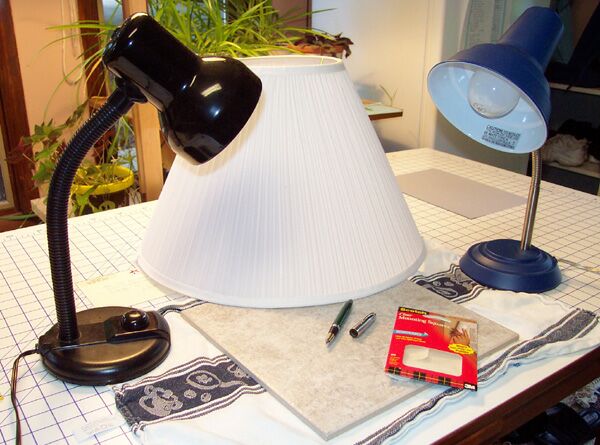
Party Time!
I also did some subject searches on pen and watch websites and discovered a secret: A lampshade is the poor man's light box! A moderate sized one fits easily over a set of pens, lights can be used outside the shade for indirect lighting, and the camera can be placed on the top to shoot the pens straight down. Same basic function, great results.
The Basics
First, let's talk about digital cameras. I'm a novice photographer, but I can say that the camera needs a few things to work and a few more things to make really good pictures. To do this right, your camera needs a MACRO function. Simply put, this allows you to photograph things at close distance, like 10 inches. Without this, your pictures will not be very sharp. For this technique, MACRO will need to be on all the time. You should use the automatic delayed shutter to snap your pictures. No one has totally steady hands, and this will eliminate any jiggle, which is especially important for close-up shots. Do not use flash. It will defeat the entire technique. Turn that off! I recommend using the highest resolution and cutting the pictures down in a good editor, such as Photoshop (or Photoshop Elements, if you want to save some money). Before you experiment with things like shutter speed, try the AUTO program mode. You may be pleasantly surprised with the results.
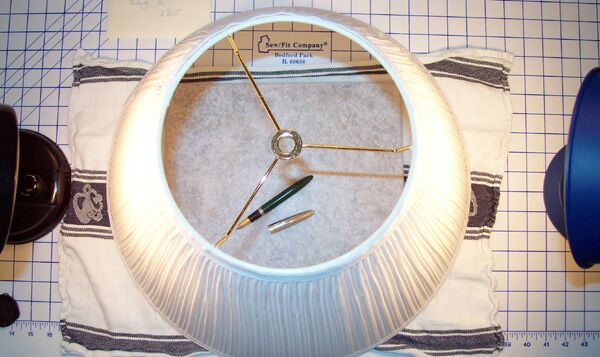
Into the Chasm!
To use this technique you probably have enough change in your sofa to fund it. You need to buy three things. Go to your local discount store and buy a cheap white or beige lampshade. Look for one about 20 inches in diameter at the bottom and about 10 inches of opening at the top. It should be about 10-12 inches high, no shorter than the minimum focal length of your camera. It should cost about US $10-$15. While you're there, get a pair of gooseneck desk lamps (incandescent only - not halogen), another US $15 each. These will probably use 60 watt bulbs, and that will be ok. If you don't have any masking tape at home, pick up a roll or get a package of 3M clear removable double sided wall tacks.
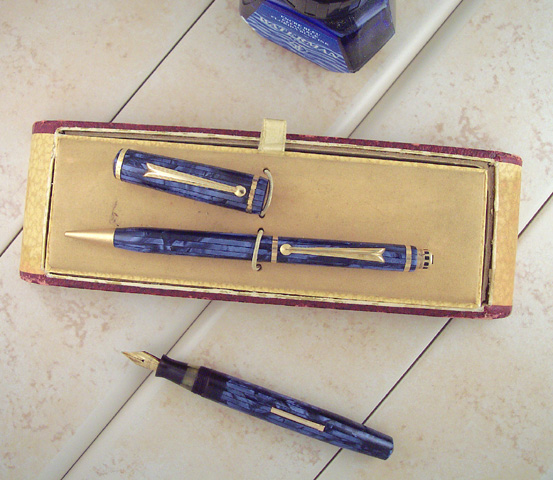
Another Typical Overhead Shot Done With A Lampshade
When you get home, find a large table and something that looks good as a background (cloth, tiles, papers - be creative), and fix that to the table top. Get the pen or pens out and experiment with placement on the background. Two rules of thumb my designer wife tells me to pass along: the eye likes to see odd numbers, so your main subject should be an odd number, and the eye likes a ¾ ratio in the picture, so "weigh" your presentation so that it tends to divide into a ¾ section and a ¼ section. Use the masking tape or the 3M sticky tacks to hold the pens firmly in place. Once you've settled on the picture, set the lampshade over the top of the pen and set the camera on the crossbars of the top of the lampshade.
If your camera has an LCD viewfinder, turn this on so you can see the proposed picture and adjust the lampshade (pick it up and turn or move it) for the best framing. Use the zoom if you have one to adjust. Take your two lights and set them on either side of the lampshade and turn them on. Look at the LCD panel to see how the camera is adjusting to the lighting and move the lamps if there appear to be hot spots. Once the picture looks good, snap the picture!
Oh, by the way - turn the lights off when not in use - they're hot, and you don't want a fire or your pens melted.
Once I started this method, I went all out and started cutting and changing to get the light box I wanted. It's an easier technique than I thought it would be and I'm really happy with the results.
Try it and have fun!
Discuss / Recommend what you read on PenHero.com
Follow us on Twitter: PenHero
Add a link to PenHero.com on your blog:
(Copy & paste code)
Please only use the photo provided. Use of other photos requires permission.
The provided link photo will change as we update the site.
Comments on this article may be sent
to the author, Jim Mamoulides
PenHero.com Bibliography
